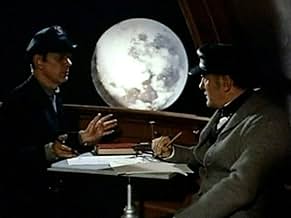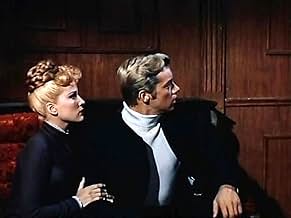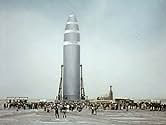NOTE IMDb
5,1/10
1,9 k
MA NOTE
Ajouter une intrigue dans votre langueIn 1868, American inventor Victor Barbicane develops a powerful military explosive that he also uses as fuel for a moon-bound rocket manned by himself and a motley crew.In 1868, American inventor Victor Barbicane develops a powerful military explosive that he also uses as fuel for a moon-bound rocket manned by himself and a motley crew.In 1868, American inventor Victor Barbicane develops a powerful military explosive that he also uses as fuel for a moon-bound rocket manned by himself and a motley crew.
- Réalisation
- Scénario
- Casting principal
Ludwig Stössel
- Aldo Von Metz
- (as Ludwig Stossel)
Morris Ankrum
- US President
- (non crédité)
Robert Clarke
- Narrator
- (voix)
- (non crédité)
Les Tremayne
- Countdown Announcer
- (non crédité)
Avis à la une
A scientist (Joseph Cotton) and a millionaire arms dealer (George Sanders) team up on the construction of a rocket to blast themselves to the Moon. This movie was based on a Jules Verne classic -- but it completely lacks the charm and the quality of `Journey to the Center of the Earth' and `20,000 Leagues Under the Sea'.
Even though the cast includes Morris Ankrum (the Grand Old Man of vintage sci-fi) to provide dignity, and Debra Paget to provide scenery (watch `Princess of the Nile' and go quietly insane), it wasn't enough to save this numbingly slow and unappealing film.
Some of the special effects are astoundingly bad, considering the fair production standards. In the scenes of the blast-off, the supporting bar which holds up the rocket model is clearly visible! Fans of `Forbidden Planet' will notice the heavy use of the `electronic tonalities' borrowed from that classic. Directed by Byron Haskins, who did both `War of the Worlds' and `The Conquest of Space'.
Even though the cast includes Morris Ankrum (the Grand Old Man of vintage sci-fi) to provide dignity, and Debra Paget to provide scenery (watch `Princess of the Nile' and go quietly insane), it wasn't enough to save this numbingly slow and unappealing film.
Some of the special effects are astoundingly bad, considering the fair production standards. In the scenes of the blast-off, the supporting bar which holds up the rocket model is clearly visible! Fans of `Forbidden Planet' will notice the heavy use of the `electronic tonalities' borrowed from that classic. Directed by Byron Haskins, who did both `War of the Worlds' and `The Conquest of Space'.
Byron Haskin was a science fiction specialist, for the big screen and also the TV industry: OUTER LIMITS, the best known and most terrific sci-fi series ever made, the most daring, brilliant, and which Byron Haskin was a lead director, with Gerd Oswald too. So it was not a surprise to enjoy this historical and fiction, Jules Verne's adaptation, movie. Joseph Cotten is wonderful in this enjoyable film, very entertaining, where tension grows all long the movie. You can be a bit bored by long talks, but don't be bothered by this. This is a great film from this director, maybe not his best, I agree, but he was the perfect choice as a director for such a topic. Of course I prefer NAKED JUNGLE or WAR OF THE WORLDS....
Certainly the effects of this film are no where near what we are used to today, but the inventiveness to even attempt to portray Vernes' rich imagination are secondary to the effort to bring such imagination from the page to the visual arts. There are inventive approaches to pre-real space travel, and the scientific accuracy (or real lack thereof) are secondary to the underlying Drama and dilemma presented about technological advances and the impact they have by affecting Man's commission of War upon his fellow man. So when watching this movie enjoy the players and do not cast aside because of reality fallacies and liberties taken in order to bring a book to visual life.
I got a real kick out of watching the hokey special effects. A space suit with a helmet that uses screws to hold it in place, and snaps up the front? How effective is that? And the odd contraption that spins the three sea-faring astronauts, and conveniently subsides in place for the first to regain consciousness to slide out of it, then rotate his two buddies in turn to exit the mechanism. I wondered who would start the thing back in motion upon re-entry
And the gyro scope! It reminded me of Jodie Foster in Contact, where she journeys through space and time in a similar invention. The extensive use of wood puts Starship Voyager to shame, and the lack of zero gravity (drinking wine to celebrate take off) is downright amusing.
But what really made the movie work for me, was the poetic language as Virginia Nicholl Debra Paget) realizes they are all going to die. We could live to we are really old, and die quietly in our sleep, but how much better to go out as star, a blazing star, for all the world to see! To which Barbicane replies, that if he ever gets back to Earth alive, he will make sure all future voyages will include a woman, for hope. How could they possibly have foreseen the catastrophic re-entry into Earth's atmosphere by Space Shuttle Columbia in February 2003? Where not just one but two women, Commander Laurel Clark and Dr. Kalpana Chawla joined five men in instant death. Sure, the parallels to Power X and atomic warfare were already obvious in 1958, but the simplistic plot tells a whole lot more. To quote a great man, 'The cause in which they died will continue. Mankind is led into the darkness beyond our world by the inspiration of discovery and the longing to understand. Our journey into space will go on.'
But what really made the movie work for me, was the poetic language as Virginia Nicholl Debra Paget) realizes they are all going to die. We could live to we are really old, and die quietly in our sleep, but how much better to go out as star, a blazing star, for all the world to see! To which Barbicane replies, that if he ever gets back to Earth alive, he will make sure all future voyages will include a woman, for hope. How could they possibly have foreseen the catastrophic re-entry into Earth's atmosphere by Space Shuttle Columbia in February 2003? Where not just one but two women, Commander Laurel Clark and Dr. Kalpana Chawla joined five men in instant death. Sure, the parallels to Power X and atomic warfare were already obvious in 1958, but the simplistic plot tells a whole lot more. To quote a great man, 'The cause in which they died will continue. Mankind is led into the darkness beyond our world by the inspiration of discovery and the longing to understand. Our journey into space will go on.'
After TWENTY THOUSAND LEAGUES UNDER THE SEA and AROUND THE WORLD IN EIGHTY DAYS it is most likely that the most popular of Jules Verne's titles (the ones that most people are familiar with) is his 1865 novel FROM THE EARTH TO THE MOON, together with it's first sequel, the 1870 novel AROUND THE MOON. What fascinates everyone is that for all the errors we now know of Verne's huge cannon idea (it would crush and vaporize the space travelers before they left the cannon's mouth) he was on target on so many points. He felt the Americans would do it first (we did - though barely); It would be sent from Florida (near where Cape Kennedy is located, by the way); Texas would be important in the project (in the novel Texas wants the honor of being the site of the cannon, but in reality Nasa's central space tracking center is in Houston); The capsule would be bullet shaped (not quite correct, but look at the rockets we used); The capsule would return to the earth and land in the Atlantic, to be recovered by an American battleship. Nice guesswork (or homework) Jules! To be fair to Verne, even his cannon idea was not a bad one - it was more plausible than Cyrano de Bergerac's bottles of morning dew (which his poetic fancy said would lift the traveler) or Poe's free flying balloon in HANS PFALL. But what is not noticed by most readers (due to translations) is Verne's social and political satire. He liked Americans, but he recognized our bellicosity, self-image building (we always did it better than anyone else) and our economic and political expansionism. Verne, like many Frenchmen, supported Lincoln and the North in the Civil War, especially after the Emancipation Proclamation. In 1887 he wrote a two volume novel NORTH AND SOUTH, in which the Confederates are the villains. But he saw American enterprise as haphazard and not well planned. He was very critical of it in THE FLOATING ISLAND, where greed by American millionaires destroys a remarkable artificial island. Even in his first published novel, FIVE WEEKS IN A BALLOON, at a philosophical moment one of the characters says that if the world ever is destroyed an American will have a hand in it.
So in the novel, the Baltimore Gun Club members are all leading engineers who helped the Northern cause by building better guns and cannon. Most of them are missing limbs as a result. The President of the club, J.P. Barbicane (in some versions his name is "Impey" Barbicane) has his limbs. His closest associate, the club's secretary, J.T. Maston, has most of his body, but has one hook for a hand. They are the only members with "in tact" bodies. The club is seeking something to do with it's time, after the Confederacy collapses. Barbicane suggests building the "Columbiad" (which, by the way, is the cannon, not the projectile) to travel or communicate with the moon. The plan is barely presented when Maston suggests using the cannon instead to annex Mexico! See - Verne has our bellicosity down quite pat.
Barbicane has a wartime rival, one Captain Nicholl. Nicholl specialized in better and better armor. Barbicane specialized in better and better shells to pierce the armor. Nicholl will soon become the leading critic of the scheme.
Verne (in real life) was a friend of the prominent aeronaut and photographer, Nadar. Nadar became the model for the French adventurer Michel Ardan (note the anagram last name for "Nadar") who proposes traveling in the projectile to the moon. Barbicane and Nicholl end up joining him (while Maston will be in charge of carefully following their travel by powerful telescope). The flight actually had great accuracy in detailing the length of the trip (four days) and in showing the amazing effect of weightlessness (Verne noted that by leaving the gravity field of earth this would result). The capsule never lands on the moon (it couldn't, because if it had it would not have been capable of getting back. Verne explains that there is a miscalculation in the calculations of the trajectory. This enables the moon to help send the capsule back to earth.
Nadar/Ardan is not in the movie. Nicholl does not become so completely involved and willing to work with Barbicane as the novel shows. George Sanders' Stuyvesant Nicholl ("Stuyvesant"?) remains hostile to Joseph Cotton's Victor Barbicane (what happened to "Impey") up to a few minutes before the conclusion. There is no power X in the novel - no new energy source. The movie was made in the 1950s, so the public had to think that Verne was thinking in terms of atomic power. Actually he never did. There is no romance between the children of Sanders and Cotton. These changes in the film help weaken the film in comparison to the novel (which still reads well - try to get the translation by Walter Miller that is the best in English).
This was not the only film version of the novel. The classic early film by George Melies, A TRIP TO THE MOON, has a period charm that makes one forget it's cardboard backgrounds (and it's projectile in the eye of the man in the moon is a classic moment of cinema). And then there was the film ROCKET TO THE MOON which turned the story into an all-star comedy with Burl Ives, Terry-Thomas, Lionel Jeffries, and Dennis Price.
Verne was not finished with his travelers either, after AROUND THE MOON. In 1889 he wrote THE PURCHASE OF THE NORTH POLE, where the Gun Club decides to use the Columbiad to alter the tilt of the globe. Ardan does not reappear, but Barbicane, Nicholl, and Marston do. It is not as good a novel as the first two.
So in the novel, the Baltimore Gun Club members are all leading engineers who helped the Northern cause by building better guns and cannon. Most of them are missing limbs as a result. The President of the club, J.P. Barbicane (in some versions his name is "Impey" Barbicane) has his limbs. His closest associate, the club's secretary, J.T. Maston, has most of his body, but has one hook for a hand. They are the only members with "in tact" bodies. The club is seeking something to do with it's time, after the Confederacy collapses. Barbicane suggests building the "Columbiad" (which, by the way, is the cannon, not the projectile) to travel or communicate with the moon. The plan is barely presented when Maston suggests using the cannon instead to annex Mexico! See - Verne has our bellicosity down quite pat.
Barbicane has a wartime rival, one Captain Nicholl. Nicholl specialized in better and better armor. Barbicane specialized in better and better shells to pierce the armor. Nicholl will soon become the leading critic of the scheme.
Verne (in real life) was a friend of the prominent aeronaut and photographer, Nadar. Nadar became the model for the French adventurer Michel Ardan (note the anagram last name for "Nadar") who proposes traveling in the projectile to the moon. Barbicane and Nicholl end up joining him (while Maston will be in charge of carefully following their travel by powerful telescope). The flight actually had great accuracy in detailing the length of the trip (four days) and in showing the amazing effect of weightlessness (Verne noted that by leaving the gravity field of earth this would result). The capsule never lands on the moon (it couldn't, because if it had it would not have been capable of getting back. Verne explains that there is a miscalculation in the calculations of the trajectory. This enables the moon to help send the capsule back to earth.
Nadar/Ardan is not in the movie. Nicholl does not become so completely involved and willing to work with Barbicane as the novel shows. George Sanders' Stuyvesant Nicholl ("Stuyvesant"?) remains hostile to Joseph Cotton's Victor Barbicane (what happened to "Impey") up to a few minutes before the conclusion. There is no power X in the novel - no new energy source. The movie was made in the 1950s, so the public had to think that Verne was thinking in terms of atomic power. Actually he never did. There is no romance between the children of Sanders and Cotton. These changes in the film help weaken the film in comparison to the novel (which still reads well - try to get the translation by Walter Miller that is the best in English).
This was not the only film version of the novel. The classic early film by George Melies, A TRIP TO THE MOON, has a period charm that makes one forget it's cardboard backgrounds (and it's projectile in the eye of the man in the moon is a classic moment of cinema). And then there was the film ROCKET TO THE MOON which turned the story into an all-star comedy with Burl Ives, Terry-Thomas, Lionel Jeffries, and Dennis Price.
Verne was not finished with his travelers either, after AROUND THE MOON. In 1889 he wrote THE PURCHASE OF THE NORTH POLE, where the Gun Club decides to use the Columbiad to alter the tilt of the globe. Ardan does not reappear, but Barbicane, Nicholl, and Marston do. It is not as good a novel as the first two.
Le saviez-vous
- AnecdotesSome of the music is actually the "electronic tonalities" created by Louis Barron and Bebe Barron for Planète interdite (1956).
- GaffesDespite dire warnings of death should occupants of the projectile NOT be in the "acceleration tubes" upon launch, no explanation is offered as to why Virginia isn't turned to goo by stowing away in another room.
- Crédits fousOpening credits are on the pages of a book, with the leads' photos included above the name.
- ConnexionsReferenced in Trumbo (2007)
- Bandes originalesElectronic Tonalities
(uncredited)
from Planète interdite (1956)
composed by Bebe Barron and Louis Barron
heard during the scenes on board the rocket
Meilleurs choix
Connectez-vous pour évaluer et suivre la liste de favoris afin de recevoir des recommandations personnalisées
- How long is From the Earth to the Moon?Alimenté par Alexa
Détails
- Date de sortie
- Pays d’origine
- Langue
- Aussi connu sous le nom de
- From the Earth to the Moon
- Lieux de tournage
- Sociétés de production
- Voir plus de crédits d'entreprise sur IMDbPro
- Durée1 heure 41 minutes
- Rapport de forme
- 1.85 : 1
Contribuer à cette page
Suggérer une modification ou ajouter du contenu manquant

Lacune principale
By what name was De la Terre à la Lune (1958) officially released in India in English?
Répondre































